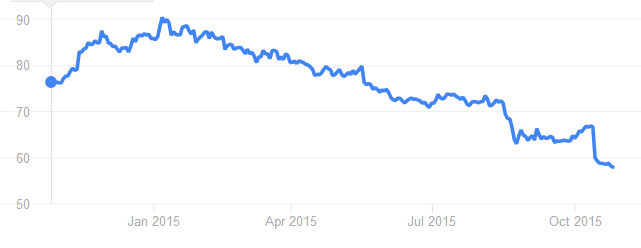"It's the objective of every retailer to grow their inventory slower than sales," Foran told the Journal. "We just carry too much inventory. And we carry too much inventory across most parts of the box. And so we do have lots of work under way to get that sorted."
Walmart's Stock Price has Fallen Sharply in 2015

Walmart Suppliers are Nervous
Of course, when mighty Walmart gets a cold, thousands of consumer goods manufacturers catch pneumonia.
First, some manufacturers may find some or all of their products lose their position on Walmart store shelves, which happened to many brands and individual items in 2009 when Walmart reduced the number of vendors it used in many product categories.
In addition, suppliers are concerned Walmart will find other ways to have them take on more of Walmart's costs.
This past summer, for example, Walmart asked vendors to pay a fee for passing products through its distribution centers – a sort of handling fee - and accept longer payment windows. (See Walmart Greatly Extending Payment Terms, Asking Some Vendors to Pay DC Handling Fee.)
The Wall Street Journal reports that several large vendors have told Walmart flat-out that they cannot agree to these new terms, saying the new contracts will increase the cost of doing business and force them to raise prices.
An executive at another large consumer goods company told the Journal he and other suppliers are worried that there will be "increased pressure on suppliers to fund their [Walmart's] problems."
"Smaller suppliers will tell me if they push this out they will go out of business. We can't afford to give them these allowances" and still sell at low prices, says Boyd Evert, a former consultant to Walmart who now owns Harvest Revenue Group, a firm that represents many suppliers in negotiations with the retailer.
Walmart, under financial and Wall Street pressure, continues to play hardball. In presentations and emails with suppliers, Walmart buyers are reportedly telling vendors their cooperation on these new terms will be considered during "line reviews," meetings that establish how much shelf space each SKU will receive.
Suppliers are also said to be concerned about the impact on their sales from Walmart's pullback in promotional displays, which are bigger drivers of volume for many vendors.
Walmart is also said to be using advanced analytics to decide which SKUs to keep and which to cut, and when inventory "clutter" in the stores is good for sales and when it isn't.
It's all a very high stakes game for both Walmart and its vendors.
What do you think of Walmart's plan to reduce SKU counts? What about asking vendors to take on more supply chain costs? Let us know your thoughts at the Feedback section below - replies will remain anonymous upon request.
SCDigest is Twittering!Follow us now at https://twitter.com/scdigest |